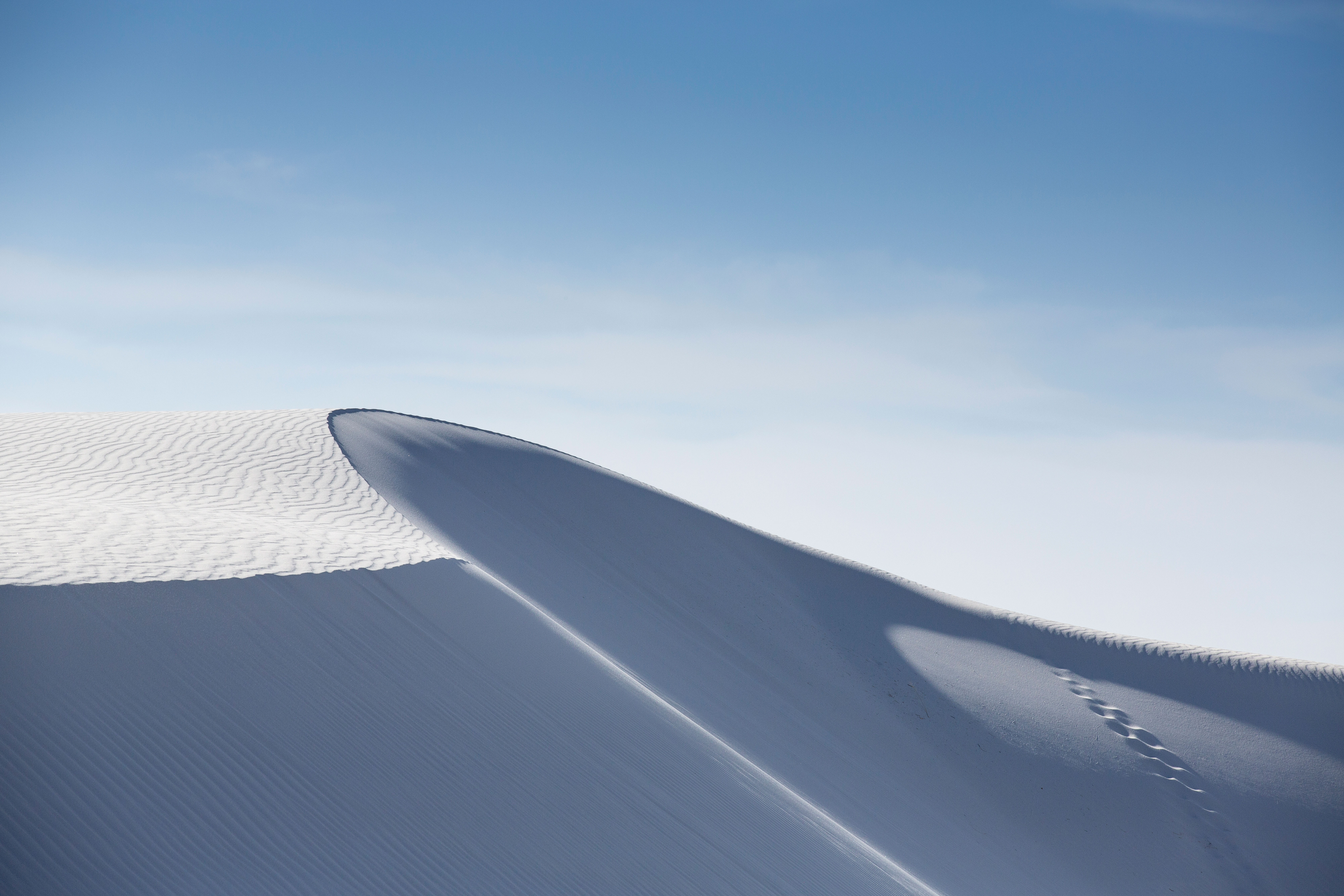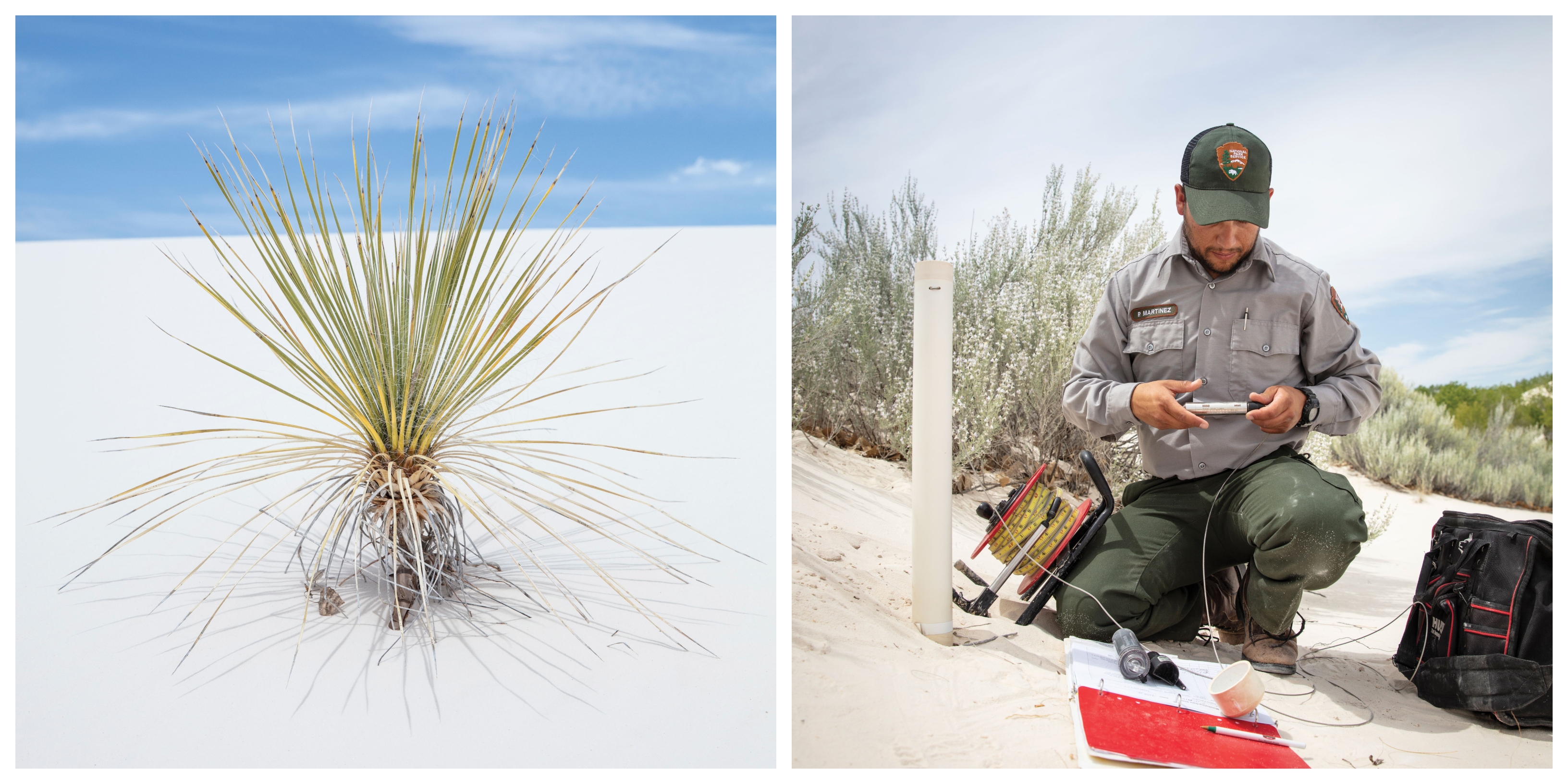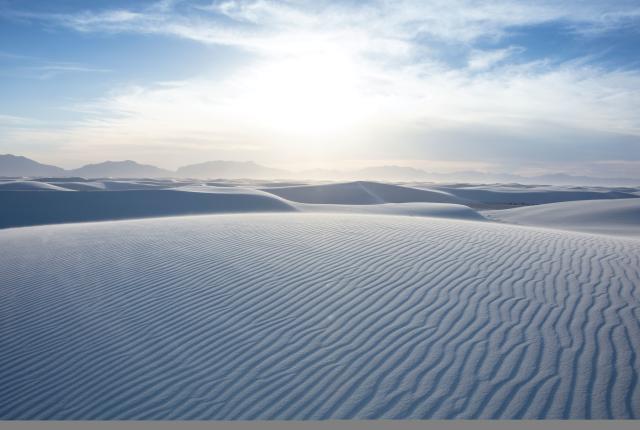Photographs by Jen Judge.
I’m careening among huge sand dunes, and hanging on for dear life. Not that Patrick Martinez, a polite and gracious biotechnician, has suddenly gone loco behind the wheel of his Polaris ATV. It’s just that White Sands National Monument, where he works, seems to bring out another side to everything.
Normally dark lizards get a curious hankering to turn pale. Typically squat yuccas gloat atop 30-foot stalks—until the sand shifts below and they topple over. During summer storms, fairy shrimp, dormant for decades, spring to life in impromptu lakes. Out on the flats, prehistoric camel tracks drift like hallucinations into the shimmering distance.
If you thought White Sands was just an inland beach, think again. True, thousands of folks visit the monument near Alamogordo each year to romp among the drifts, camp beneath a Cyclops moon, or sneak a peek at celebs such as model Kendall Jenner doing photo shoots. But the open-air laboratory is full of scientific surprises that seem to reveal themselves with every shifting dune.
Like this one: Archaeologists recently discovered footprints left by fearless—and undoubtedly hungry—prehistoric humans as they hunted an eight-foot-tall, razor-clawed, and very cantankerous sloth. These breakthroughs about what’s called the “White Sands trackway,” vividly recounted through ranger-guided tours and a new visitor-center exhibit, show that this ivory sea has always teemed with scrappy life.
Today, my exuberant crew is only adding to the legend. As Martinez bounces up and down the hills, biologist David Bustos, his co-worker, can barely stifle a grin in the seat next to me. Who can blame him? Few places on earth are more eternally eccentric. We stop and Bustos snugs his sunglasses against the crystalline glare. “People just see dunes,” he says. “But even 10 years ago, we didn’t know that we possibly have one of the largest concentrations of Ice Age megafauna footprints in America. It’s very dynamic, and all of this stuff is changing the way people think about the past.”
AT ROUGHLY 275 SQUARE MILES, White Sands ranks as the world’s largest gypsum dune field, extending beyond the monument’s boundaries. Topographical maps are a waste of time here. Young dunes can ramble almost 40 feet in a single year and soar 60 feet above the desert floor. Crazier still, the whole white desert is held together by water. To make this point, we stop alongside a gray metal tube poking out of the ground. Bustos kneels, screws a cap off the tube, and measures the groundwater level. It’s just inches below us. He scrapes back a bit of sand with his glove, baring gypsum that is moist and hard.

Above: A day at White Sands National Monument includes sledding down dunes, hiking, and observing the desert's natural wonders.
"This shallow aquifer keeps the dunes in place,” he explains. “If there wasn’t this high water table, they would just dry out and blow away. People don’t think there’s any water here, but actually there’s water everywhere.”
And where there is water, there is ever-changing life. Like Darwin’s Galápagos Islands, White Sands is an evolutionary petri dish. Among animals, the key adaptation is to get white. That allows them to hide from predators and stay cooler in the summer heat. From the 1920s to the 1960s, researchers discovered at least seven species that had turned permanently light-colored within the dunes, even as their cousins on the outside remained dark. “We have an animal from nearly every class of vertebrate that has adapted to White Sands,” Bustos says.
HOW DO YOU CREATE an enormous gypsum dune field? It helps if you’ve got 250 million years to work on it. That’s how long ago gypsum sediments began settling in a shallow, inland sea here. About 10 million years ago, those sediments were thrust upward, creating the San Andres and Sacramento Mountains, which ring today’s Tularosa Basin. Every time it rains, the water carries that gypsum down once more, replenishing the dunes.
What results is a quirky tango between geology and biology. “It’s one of the only places in the world where you can see a succession from rock or crystal to sand to dune,” says Bustos, “and every step along this process has these little micro-habitats and niches in the ecosystem. So the bacteria, the microbes, the plants, the animals—everything changes dramatically.”
Increasingly, scientists are tracing this evolutionary drama straight back through millennia. “Recently, we’ve been finding thousands and thousands of fossilized footprints of mammoths and camels, dire wolves and sloths,” Bustos says. “What drew all those creatures is the same thing that draws them today: There was always water here. This was one of the largest wetlands in the prehistoric Southwest.

In the 1970s, in a roundabout way, those wetlands also drew the attention of archaeologist and longtime NMSU professor Peter Eidenbach. I meet with him on the breezy patio of a hilltop Alamogordo coffee shop, exquisite views of the cloud-dappled Tularosa Basin spreading far below us. He looks to be the quintessential desert sage, with round glasses and a rangy beard that dances in the wind. Within that world’s biggest gypsum deposit, he says, lies “some of the most intact prehistoric archaeology around”—beyond mammoth bones and camel prints. On a survey by horseback in 1973, he and a colleague put the ancient Jornada Mogollon people on the map by unearthing 65 campfire sites they’d left behind from 500 BC to AD 1450. The Jornada “was a culture that developed right in place from the archaic people of an earlier period,” Eidenbach says. “They were hunting populations, Paleo Indian people who were adapted to the Chihuahuan Desert.”
Read more: The 10 Best Barbecue Restaurants in New Mexico.
But as the environment changed and grasslands withered, the Jornada Mogollon were forced to change as well. “Instead of hunting big game, like mammoths, American camels, early horses, and ground sloths,” he says, “they started to explore mountains. At some point, around 4,000 years ago, they obtained corn from Mexico and started to grow it as a supplementary crop. Then, as their population grew, they had to intensify their agriculture. So they developed villages along major arroyos, used dry-land irrigation, and started developing pottery—brown ware, red on brown—along with various polychromes.”
They also left behind an abundance of rock art—intriguing images of people, animals, and symbols still visible at the Three Rivers Petroglyph Site, 20 miles north of Tularosa—a perfect spot to ponder this vanished culture.
All of which begs the question: Where did they go? Eidenbach sighs and sips his coffee; among archaeologists, this is the million-dollar question. “Well,” he says, “I think as the climate changed in the 14th and 15th centuries, that’s when the Great Plains became full of bison. Hunting is a lot easier than farming. I think these people largely migrated eastward and went buffalo hunting.”

Above: The beauty and the science of sands and native plants engage biotechnician Patrick Martinez.
BY COMPARISON, TODAY'S visitors to White Sands National Monument—established by Herbert Hoover in 1933—have a cakewalk, especially if they choose to go in cooler-weather months. (Take the warm-weather warnings about adequate hydration and a shady hat seriously.) The ADA-accessible Interdune Boardwalk stretches a few feet above the sand and is dotted by excellent tutorials on plants, animals, and the old lakebed’s restless nature. The Dune Life Nature Trail moves the tale forward, traversing what’s called an “ecotone,” or the meeting place between desert scrub and gypsum dunes.
Read more: How to Hike Southern NM's Argentina Canyon.
There you might see the “tail trail” of the Cowles prairie lizard that disappears in a flurry of sand, and the crescent indentations of an Apache pocket mouse, scurrying to the nearest sumac bush. You could spot the fierce splay of a roadrunner’s feet, or paw prints from a lonely coyote climbing some wind-scalloped slope. All of these clues are delicate, soon to be swallowed by shifting sands.
Back at the Polaris, Bustos describes the entire dune field as a living organism, which aids in its preservation and keeps it from being loved to death by visitors. “The dunes move so fast that any impact upon them is minimal,” he says.
As the sun gets higher, he glances at the surrounding white slopes and gets philosophical. “You know, this has been a place of life for humans and animals for thousands and thousands of years, and we’re just starting to understand how diverse it is,” he says. “It’s such a strange, complex place. It seems very simple until you start inspecting it a little bit and then it’s like Holy cow. It’s too much.”
Martinez looks around and nods in agreement. Then he fires up the Polaris. We climb aboard and roar off into this mischievous sea of white.

INTO THE GREAT WHITE OPEN
Now in its 85th year, White Sands National Monument sits in southern New Mexico between Alamogordo and Las Cruces, either of which offers plenty of lodging and eating options.
The monument is open daily except Christmas. Call ahead or check its Facebook page; it closes for tests at the nearby White Sands Missile Range. Gates open at 7 a.m.; visitors must leave by nightfall (6 p.m., November 4–December 24). Admission is $5 a person, free for ages 15 and under. Primitive campsite permits are an extra $3 a person, $1.50 for ages 15 and under.
You can drive up to 16 miles in a loop to view the dunes. Feel free to hike, sled, or ride a bike on them as well. Dogs on leashes, horses, and other pack animals are welcome, too.
On November 1 and 4, tag along on guided sunset strolls. Tours of Lake Lucero Tours of Lake Lucero are on November 3 and 24 and December 29.
The visitor center has information about the region’s geology, biology, and more, along with snacks and drinks.

MURDER IN THE DESERT
A vanished colonel in White Sands is at the heart of New Mexico’s longest unsolved mystery.
One crisp morning in February 1896, Colonel Albert Jennings Fountain, an influential New Mexico lawyer, was heading home to Mesilla from Lincoln with his eight-year-old son, Henry. Near the territory’s vast White Sands, they vanished. The colonel’s buckboard wagon was found, along with plenty of blood. No bodies were ever recovered.
Fountain was a big wheel in New Mexico, having served as speaker of the House of Representatives and helped to found what would become New Mexico State University. Most recently, he’d served as chief investigator for the Southeastern New Mexico Stock Growers Association, which led him to seek cattle-rustling indictments against Tularosa Basin ranchers Oliver Lee and Jim Gilliland. He’d been in Lincoln working on the case, which immediately cast suspicion on the two men. Some three years after Fountain’s disappearance, they were charged with murder, along with an associate who was later dropped from the case.
It was the O.J. trial of its day. Sheriff Pat Garrett investigated it. Thomas B. Catron, one of the land speculators of the Santa Fe Ring, prosecuted it. Leading the defense: Albert Bacon Fall, a Fountain rival who would later face national shame in the Teapot Dome Scandal. The trial was moved to Hillsboro, near modern-day Truth or Consequences, to escape the pro-and-con passions of locals. Still, Fall didn’t hesitate to play on Tularosa sentiments favoring Lee. “The sympathy of the local community, particularly the ladies, is now with the defendants,” trumpeted the Albuquerque Journal-Democrat.
Those sentiments proved insurmountable. The two defendants were acquitted. Resentments still linger, says Jean Killer, museum curator for the Tularosa Basin Historical Society, in Alamogordo. “It depends upon which side of the mountain you come from,” she says. “If you come from the Tularosa Basin, there is very positive support of Oliver Lee in the Fountain activities—they say he had nothing to do with it. But if you’re in the Doña Ana County area where Fountain was from, it’s an entirely different story.”


